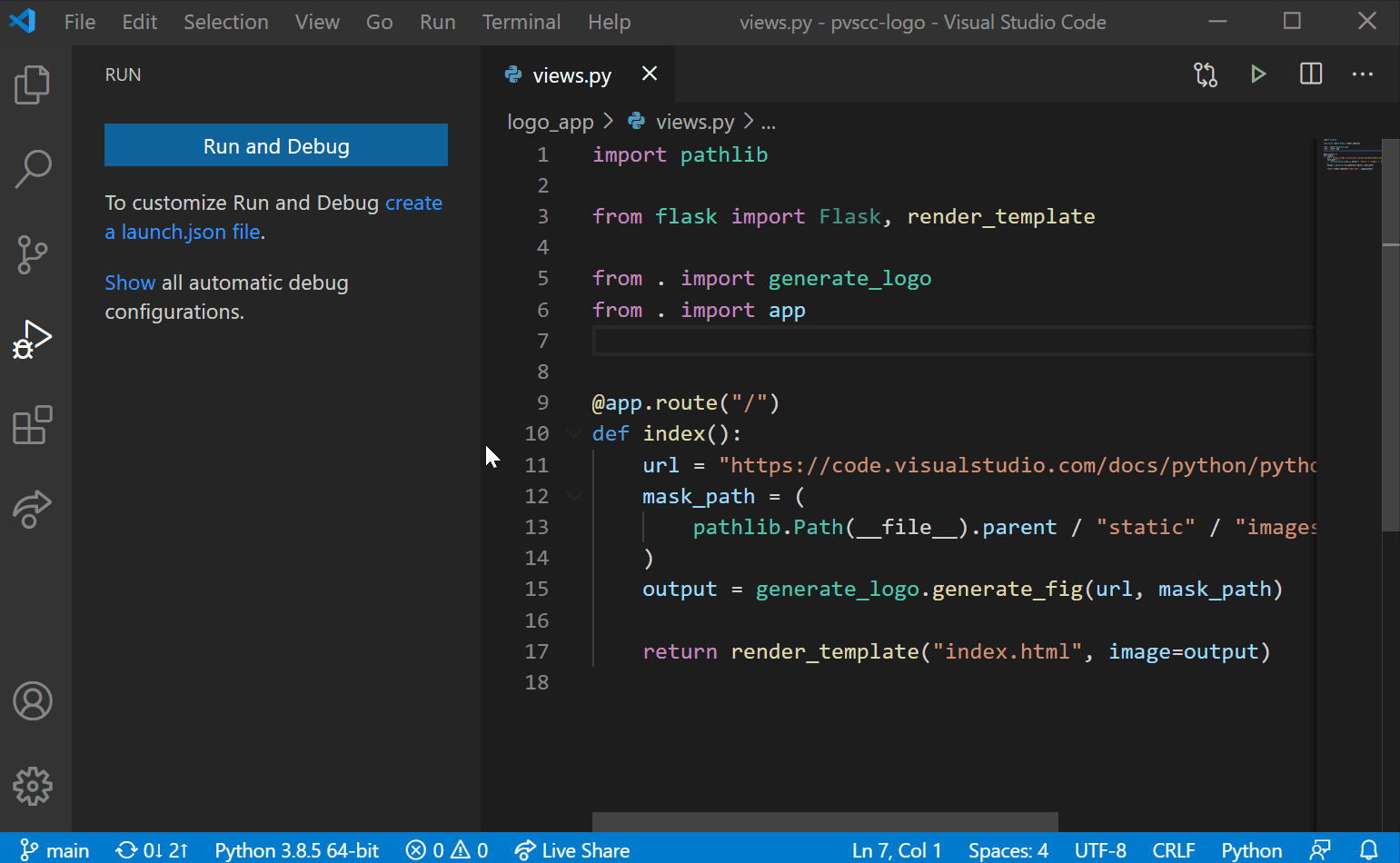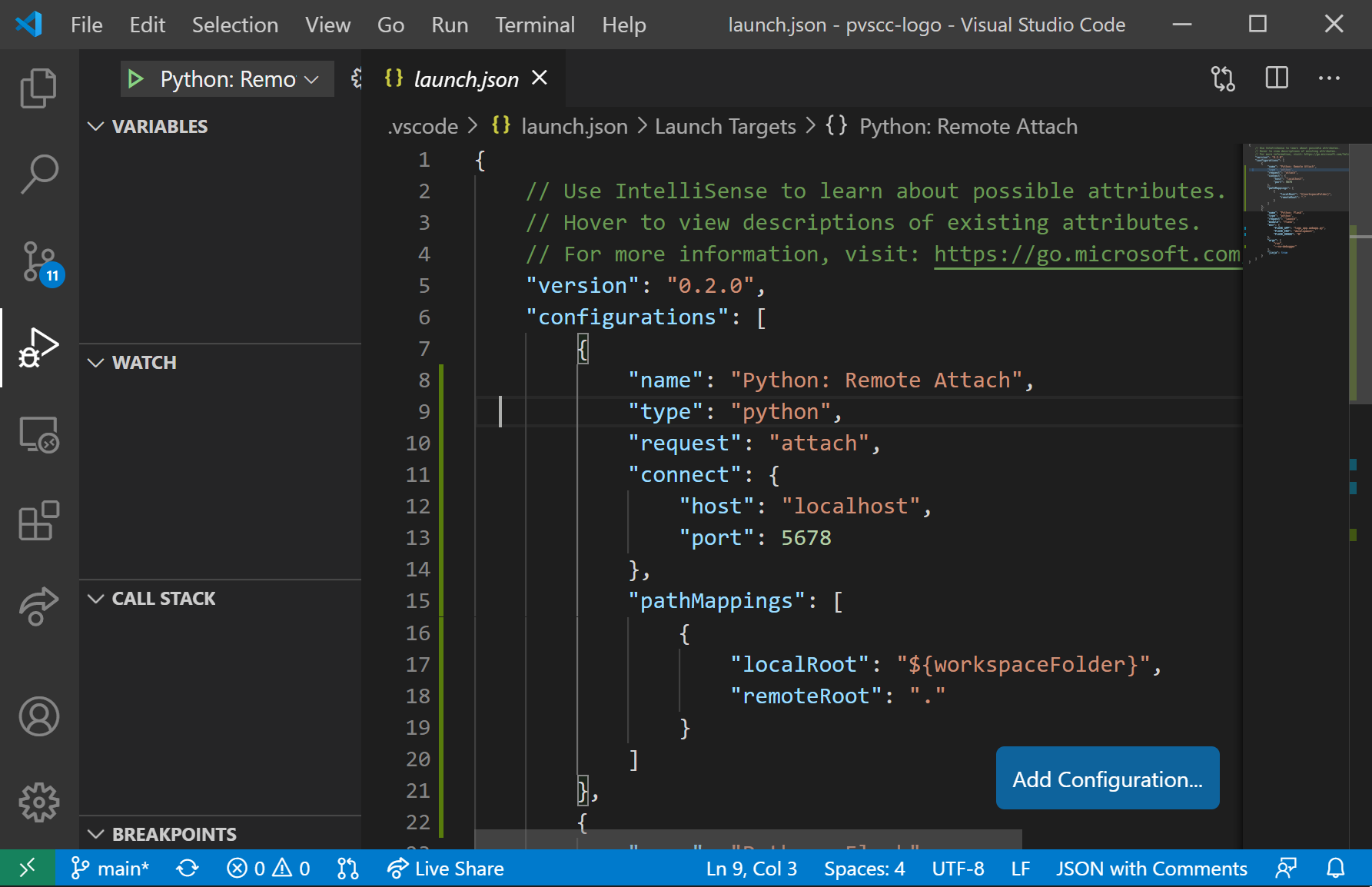- Visual Studio Code And Python Django
- Python For Visual Code
- Python On Vs Code
- Visual Studio Code Python Tutorial
By default, installing the Python development workload in Visual Studio 2017 and later also installs Python 3 (64-bit). You can optionally choose to install 32-bit and 64-bit versions of Python 2 and Python 3, along with Miniconda (Visual Studio 2019) or Anaconda 2/Anaconda 3 (Visual Studio 2017), as described in Installation.
- Visual Studio detects updates to an existing interpreter, such as upgrading Python 2.7.11 to 2.7.14 using the installers from python.org. During the installation process, the older environment disappears from the Python Environments list before the update appears in its place.
- Python visual-studio-code. Improve this question. Follow asked Sep 20 '20 at 17:41. Raghav Tyagi Raghav Tyagi. Add a comment 2 Answers Active Oldest Votes. This is because the Python interpreter is not selected for VSCode, and the Python extension of VSCode cannot identify the Python code through it.

Jul 01, 2020 Alternatively, you can also hit the Extensions icon in the left-hand pane inside Visual Studio Code and search for the keyword “ python ”. Select the extension which is provided by Microsoft and click on Install. I have already installed the extension on my machine: Figure 7 – Search and Install the Python extension for VS Code.
Alternately, you can install standard python interpreters from the Add Environment dialog. Select the Add Environment command in the Python Environments window or the Python toolbar, select the Python installation tab, indicate which interpreters to install, and select Install.
You can also manually install any of the interpreters listed in the table below outside of the Visual Studio installer. For example, if you installed Anaconda 3 before installing Visual Studio, you don't need to install it again through the Visual Studio installer. You can also install an interpreter manually if, for example, a newer version of available that doesn't yet appear in the Visual Studio installer.
Note

Visual Studio supports Python version 2.7, as well as version 3.5 to 3.7. While it is possible to use Visual Studio to edit code written in other versions of Python, those versions are not officially supported and features such as IntelliSense and debugging might not work.
For Visual Studio 2015 and earlier, you must manually install one of the interpreters.
Visual Studio (all versions) automatically detects each installed Python interpreter and its environment by checking the registry according to PEP 514 - Python registration in the Windows registry. Python installations are typically found under HKEY_LOCAL_MACHINESOFTWAREPython (32-bit) and HKEY_LOCAL_MACHINESOFTWAREWOW6432NodePython (64-bit), then within nodes for the distribution such as PythonCore (CPython) and ContinuumAnalytics (Anaconda).
If Visual Studio does not detect an installed environment, see Manually identify an existing environment.
Visual Studio shows all known environments in the Python Environments window, and automatically detects updates to existing interpreters.
| Interpreter | Description |
|---|---|
| CPython | The 'native' and most commonly-used interpreter, available in 32-bit and 64-bit versions (32-bit recommended). Includes the latest language features, maximum Python package compatibility, full debugging support, and interop with IPython. See also: Should I use Python 2 or Python 3?. Note that Visual Studio 2015 and earlier do not support Python 3.6+ and can give errors like Unsupported python version 3.6. Use Python 3.5 or earlier instead. |
| IronPython | A .NET implementation of Python, available in 32-bit and 64-bit versions, providing C#/F#/Visual Basic interop, access to .NET APIs, standard Python debugging (but not C++ mixed-mode debugging), and mixed IronPython/C# debugging. IronPython, however, does not support virtual environments. |
| Anaconda | An open data science platform powered by Python, and includes the latest version of CPython and most of the difficult-to-install packages. We recommend it if you can't otherwise decide. |
| PyPy | A high-performance tracing JIT implementation of Python that's good for long-running programs and situations where you identify performance issues but cannot find other resolutions. Works with Visual Studio but with limited support for advanced debugging features. |
| Jython | An implementation of Python on the Java Virtual Machine (JVM). Similar to IronPython, code running in Jython can interact with Java classes and libraries, but may not be able to use many libraries intended for CPython. Works with Visual Studio but with limited support for advanced debugging features. |
Developers that want to provide new forms of detection for Python environments, see PTVS Environment Detection (github.com).
Visual Studio Code And Python Django
Move an interpreter
Olive driver download for windows 10. If you move an existing interpreter to a new location using the file system, Visual Studio doesn't automatically detect the change.
If you originally specified the location of the interpreter through the Python Environments window, then edit its environment using the Configure tab in that window to identify the new location. See Manually identify an existing environment.
If you installed the interpreter using an installer program, then use the following steps to reinstall the interpreter in the new location:
- Restore the Python interpreter to its original location.
- Uninstall the interpreter using its installer, which clears the registry entries.
- Reinstall the interpreter at the desired location.
- Restart Visual Studio, which should auto-detect the new location in place of the old location.
Following this process ensures that the registry entries that identify the interpreter's location, which Visual Studio uses, are properly updated. Using an installer also handles any other side effects that may exist.
See also
Summary: in this tutorial, you’ll learn how to use set up Visual Studio Code for Python. Vizio driver download for windows.
Visual Studio Code is a lightweight source code editor. The Visual Studio Code is often called VS Code.
The VS Code runs on your desktop. It’s available for Windows, macOS, and Linux.
VS Code comes with many features such as IntelliSense, code editing, and extensions that allow you to edit Python source code effectively. The best part is that the VS Code is open-source and free.
This tutorial teaches you how to set up Visual Studio Code for Python environment so that you can edit, run, and debug Python code.
Setting up Visual Studio Code
To setup the VS Code, you follows these steps:
First, navigate to the VS Code official website and download the VS code based on your platform (Windows, macOS, or Linux).
Second, launch the setup wizad and follow the steps.
Once the installation completes, you can launch the VS code application:
Install Python Extension
To make the VS Code works with Python, you need to install the Python extension from the Visual Studio Marketplace.
Python For Visual Code
The following picture illustrates the steps:
Python On Vs Code

- First, click the Extensions tab.
- Second, type the
pythonkeyword on the search input. - Third, click the
Pythonextension. It’ll show detailed information on the right pane. - Finally, click the Install button to install the Python extension.
Visual Studio Code Python Tutorial
Now, you’re ready to develop the first program in Python.
